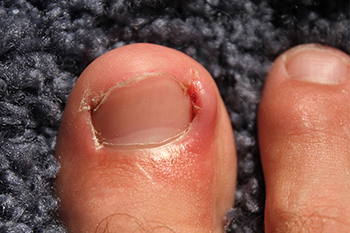- Home
- Our Doctors
- Our Offices
- New Patients
- Patient Education
- Blog
- Contact Us
- Patient Portal Help



Ingrown toenails can be a persistent source of discomfort, often caused by improper toenail care or wearing ill-fitting shoes. When conservative measures fail, surgical intervention becomes a viable solution to address the root cause and provide lasting relief. The primary goal of ingrown toenail surgery is to eliminate infection and pain. Before considering surgery, it is beneficial to implement conservative measures. These can include cutting toenails straight across and avoiding leaving sharp edges, and opting for shoes that accommodate the natural position of the toes. In some cases, a podiatrist may be able to manually address the issue by pushing the skin away from the ingrown toenail or carefully trimming the offending toenail section. Surgical procedures for ingrown toenails include nail avulsion, involving the complete removal of the toenail and wedge excision. This procedure removes the section of the toenail growing into the skin, along with the adjacent tissue. Another surgical remedy is nail-bed ablation, partial or complete toenail removal. This is followed by the application of a chemical to the tissue where the toenail originates. Electrocautery methods may also be employed. If you experience ingrown toenails on a regular basis, it is suggested that you schedule an appointment with a podiatrist for a full examination and suggested treatment options.
Ingrown toenails may initially present themselves as a minor discomfort, but they may progress into an infection in the skin without proper treatment. For more information about ingrown toenails, contact one of our podiatrists of Foot & Ankle Institue. Our doctors can provide the care you need to keep you pain-free and on your feet.
Ingrown Toenails
Ingrown toenails are caused when the corner or side of a toenail grows into the soft flesh surrounding it. They often result in redness, swelling, pain, and in some cases, infection. This condition typically affects the big toe and may recur if it is not treated properly.
Causes
You are more likely to develop an ingrown toenail if you are obese, have diabetes, arthritis, or have any fungal infection in your nails. Additionally, people who have foot or toe deformities are at a higher risk of developing an ingrown toenail.
Symptoms
Some symptoms of ingrown toenails are redness, swelling, and pain. In rare cases, there may be a yellowish drainage coming from the nail.
Treatment
Ignoring an ingrown toenail can have serious complications. Infections of the nail border can progress to a deeper soft-tissue infection, which can then turn into a bone infection. You should always speak with your podiatrist if you suspect you have an ingrown toenail, especially if you have diabetes or poor circulation.
If you have any questions, please feel free to contact one of our offices located in St. George, Hurricane, and Cedar City, UT and Mesquite, NV . We offer the newest diagnostic and treatment technologies for all your foot care needs.
Having issues or need help with your portal?
Click here for Instructional Videos